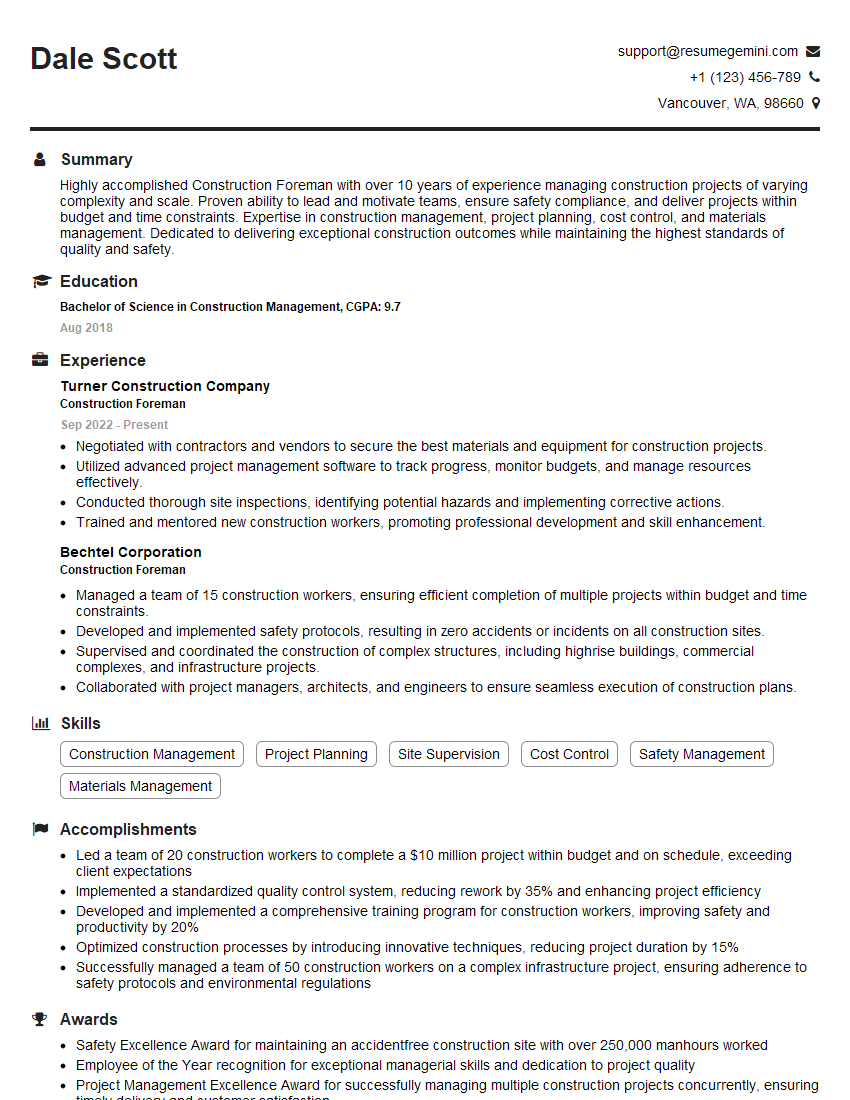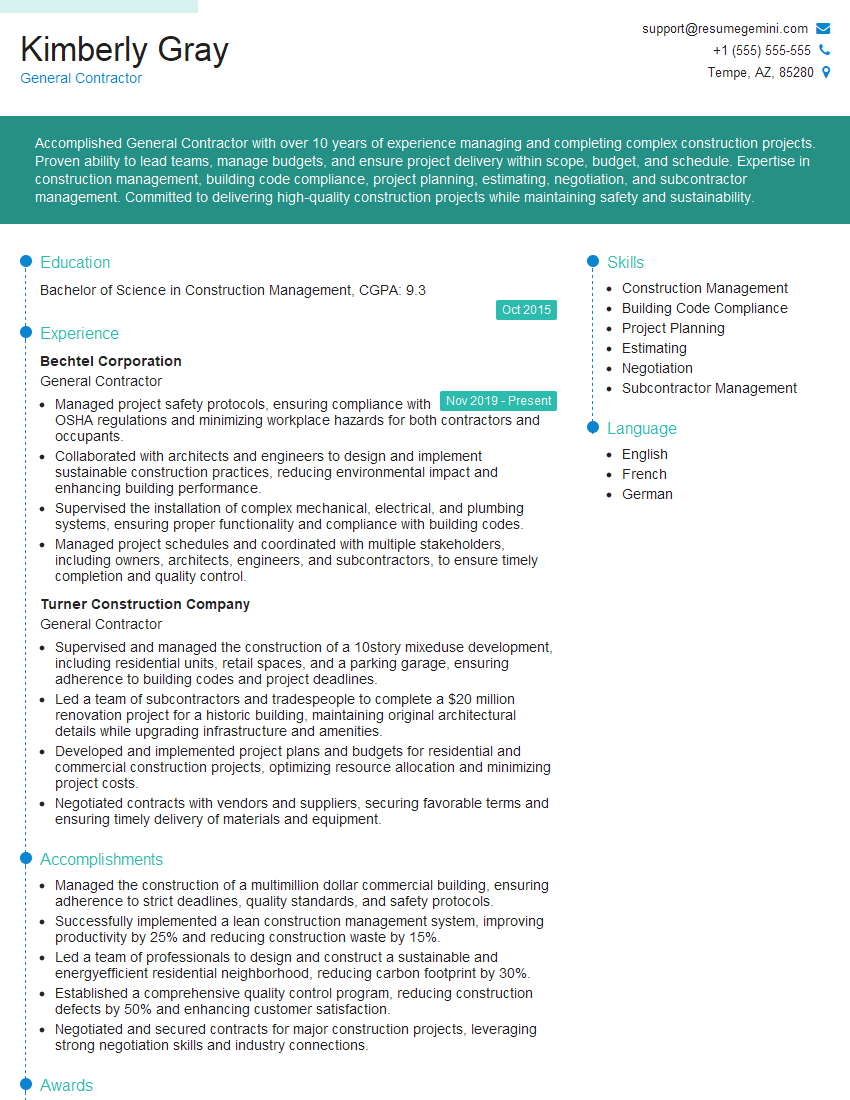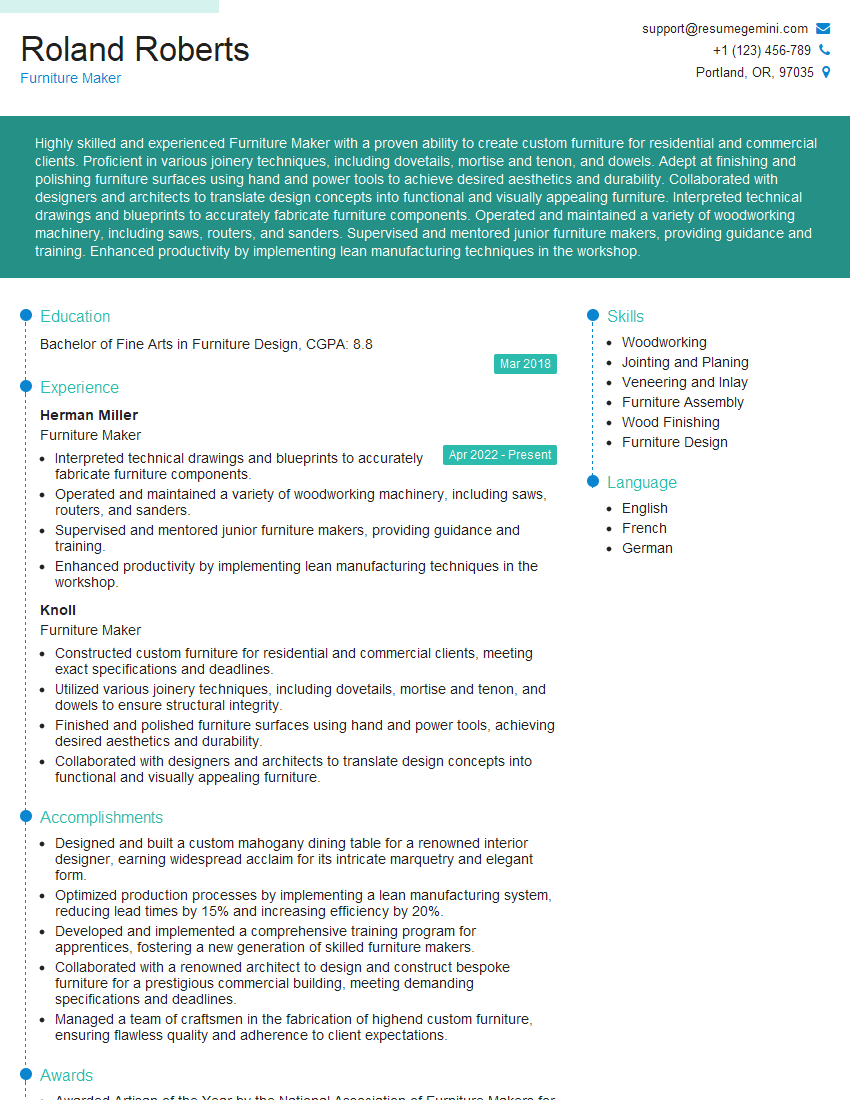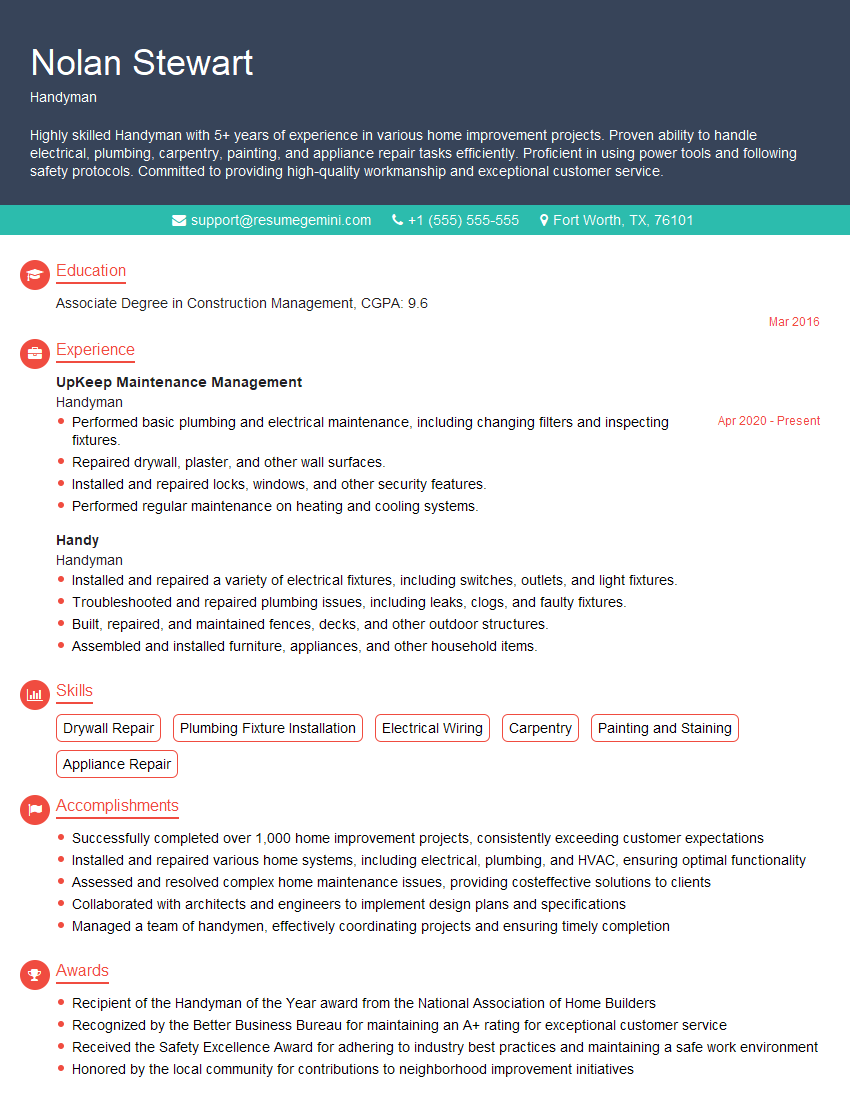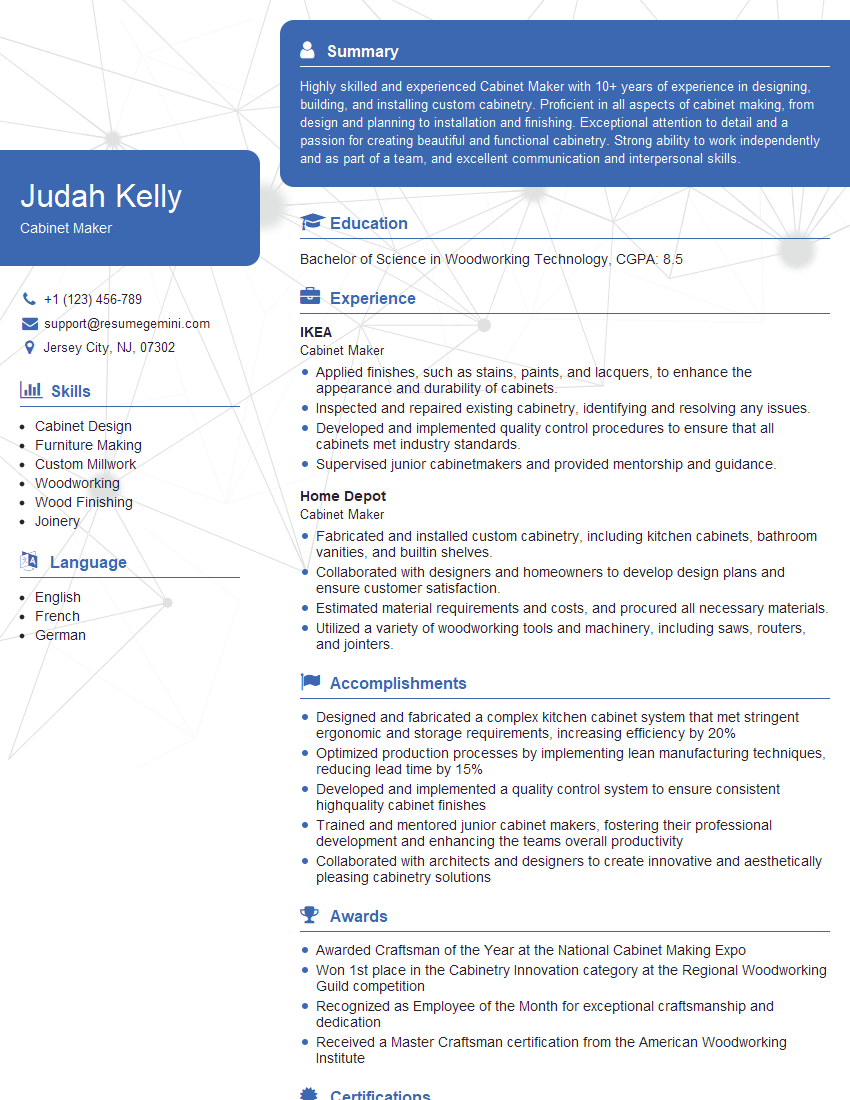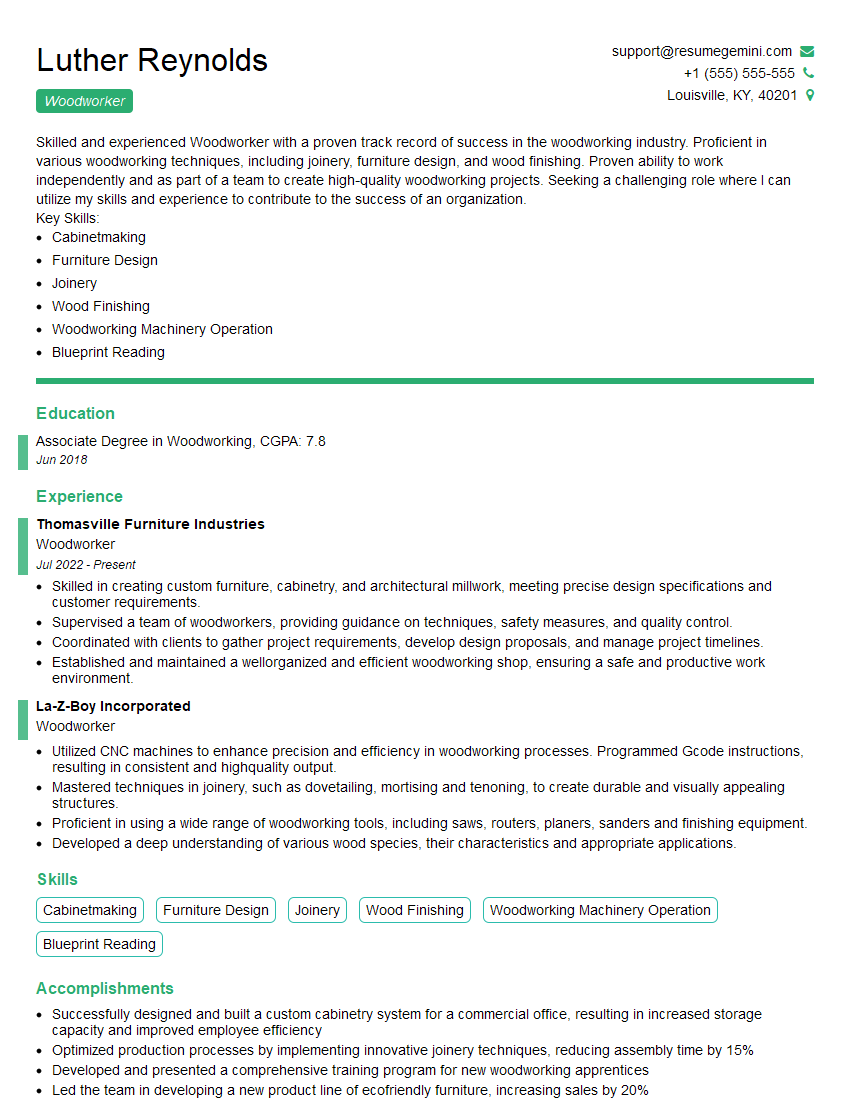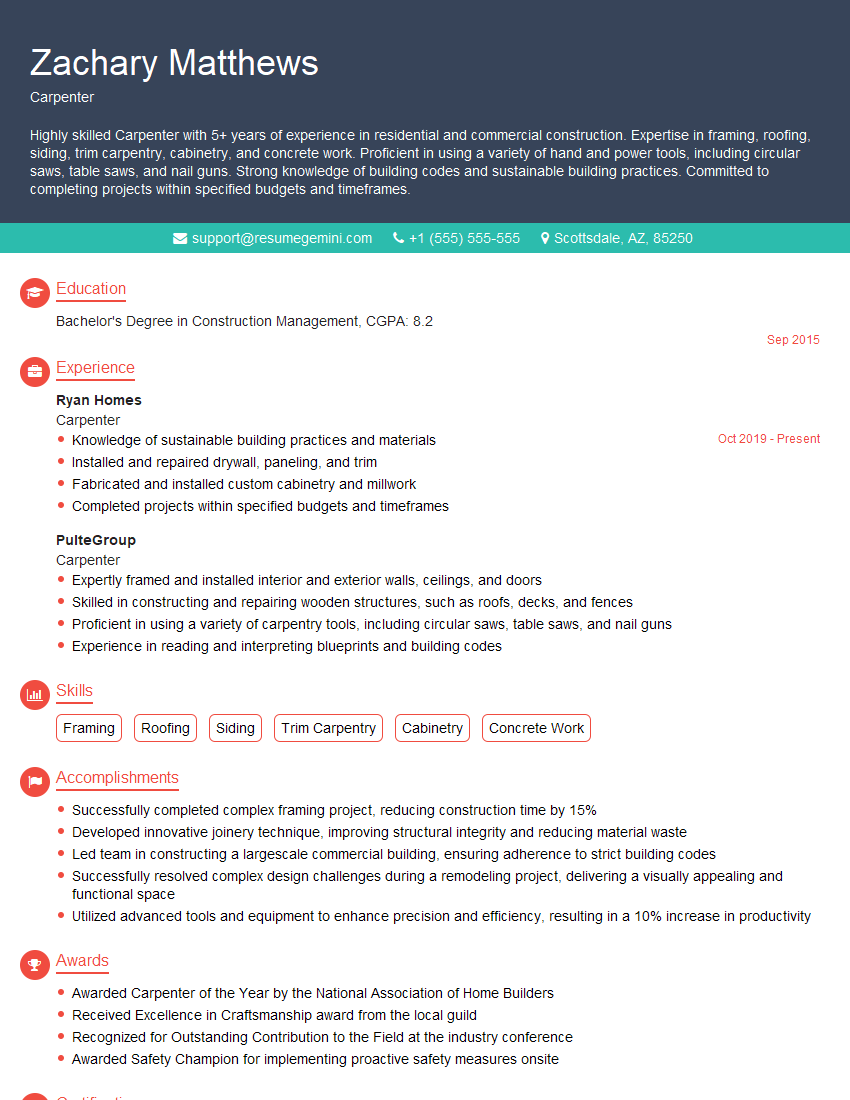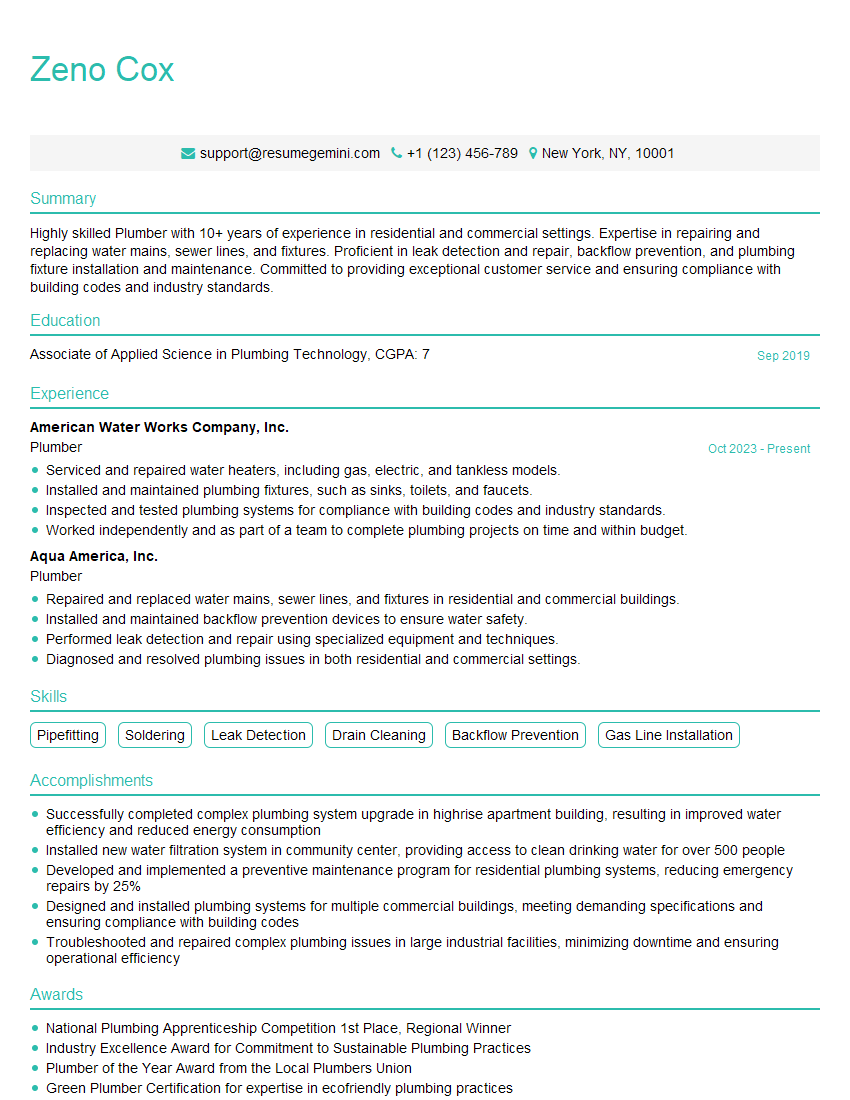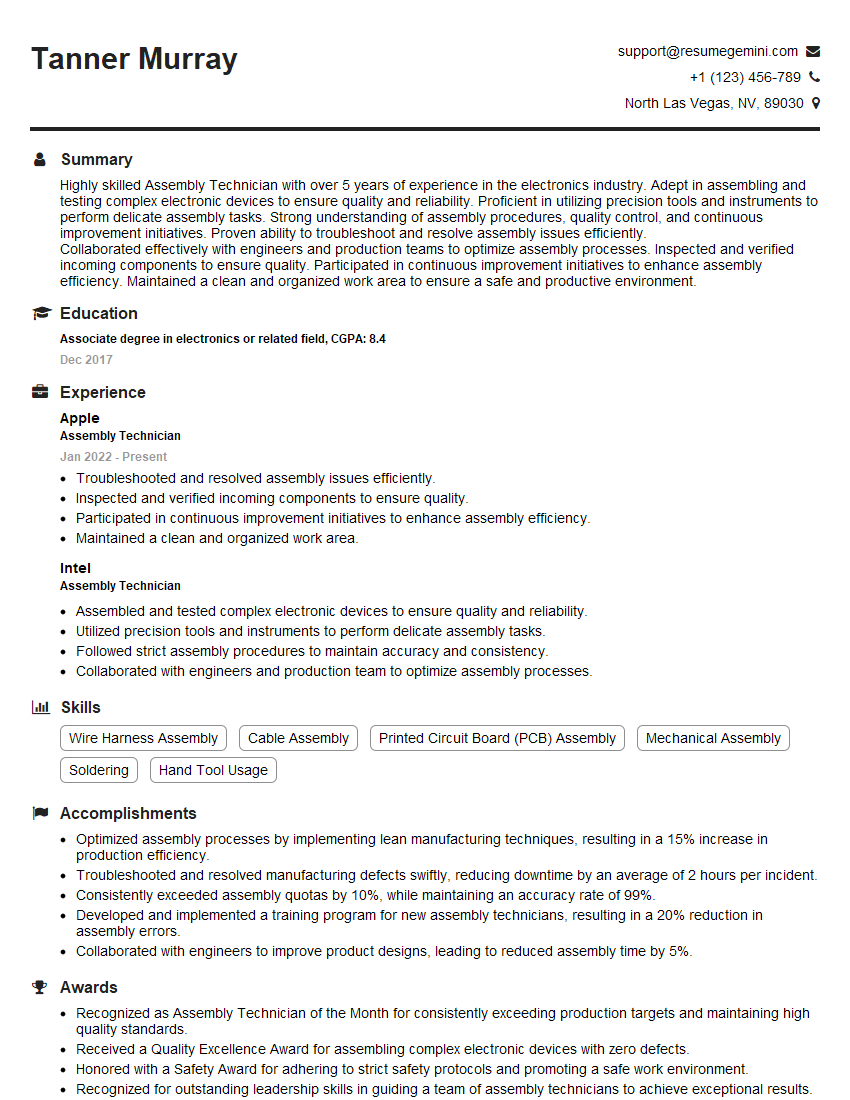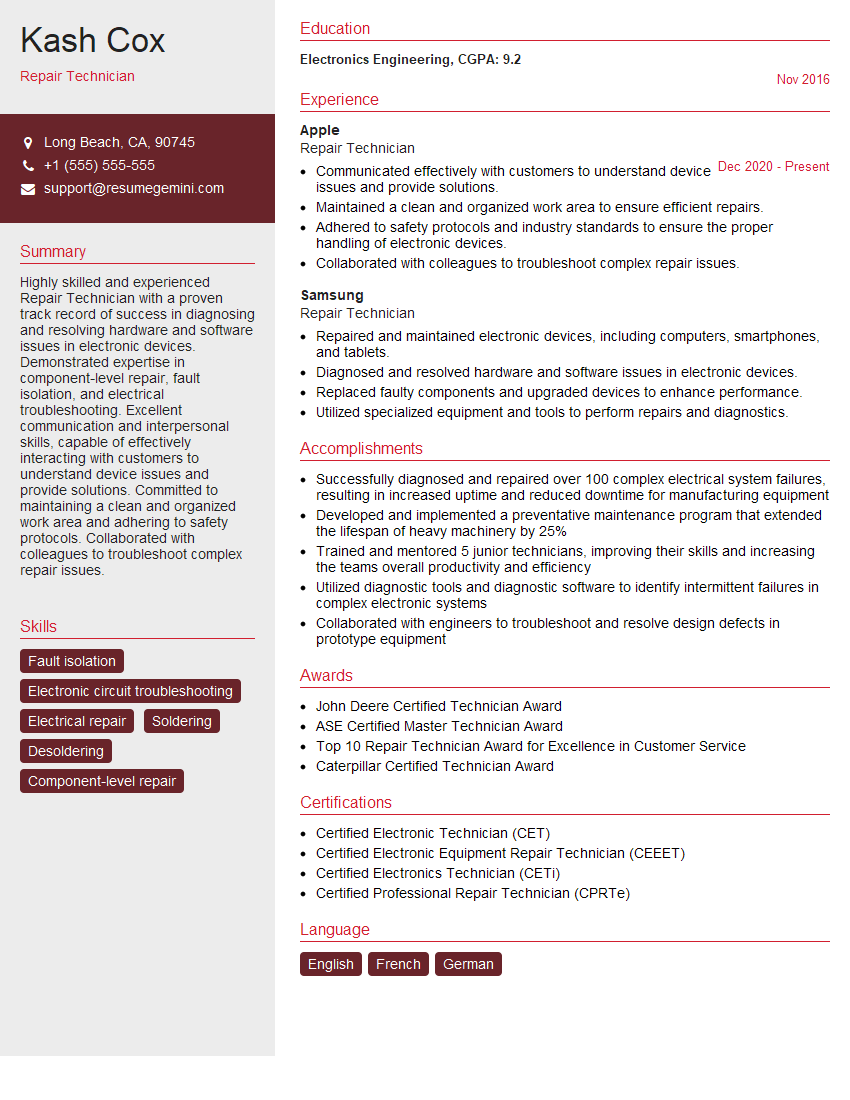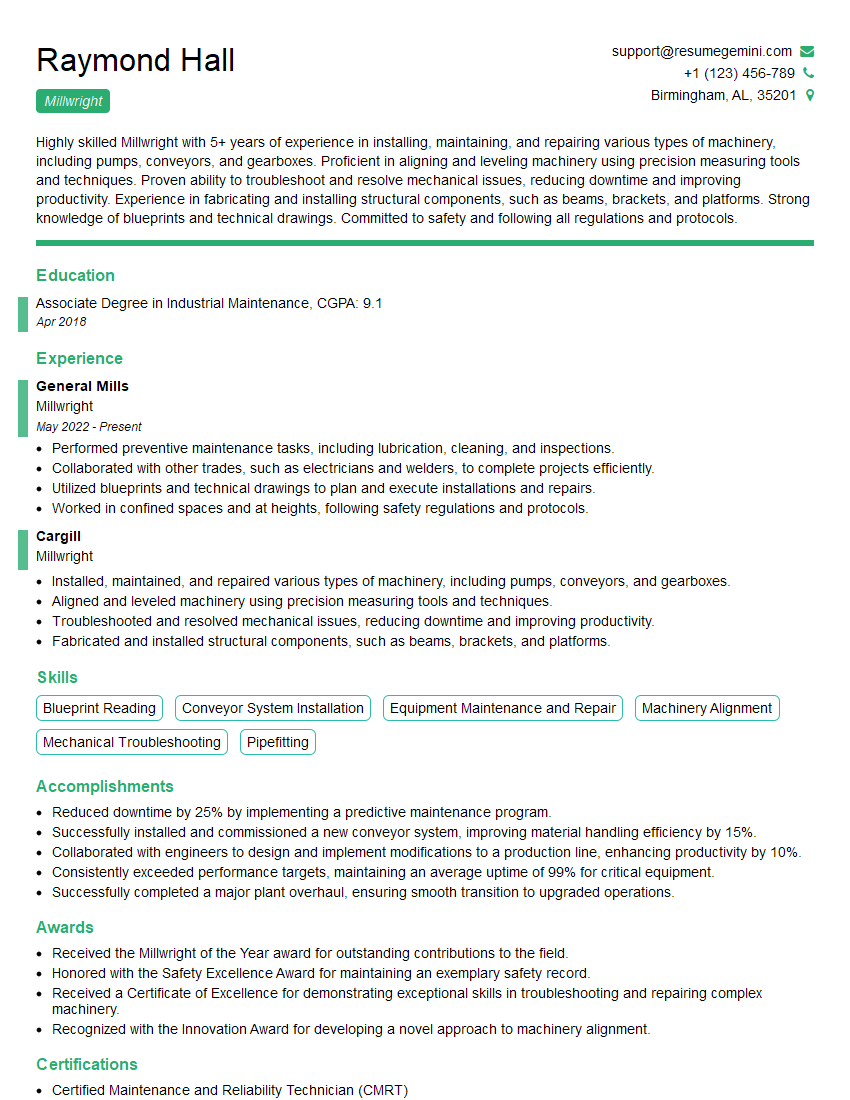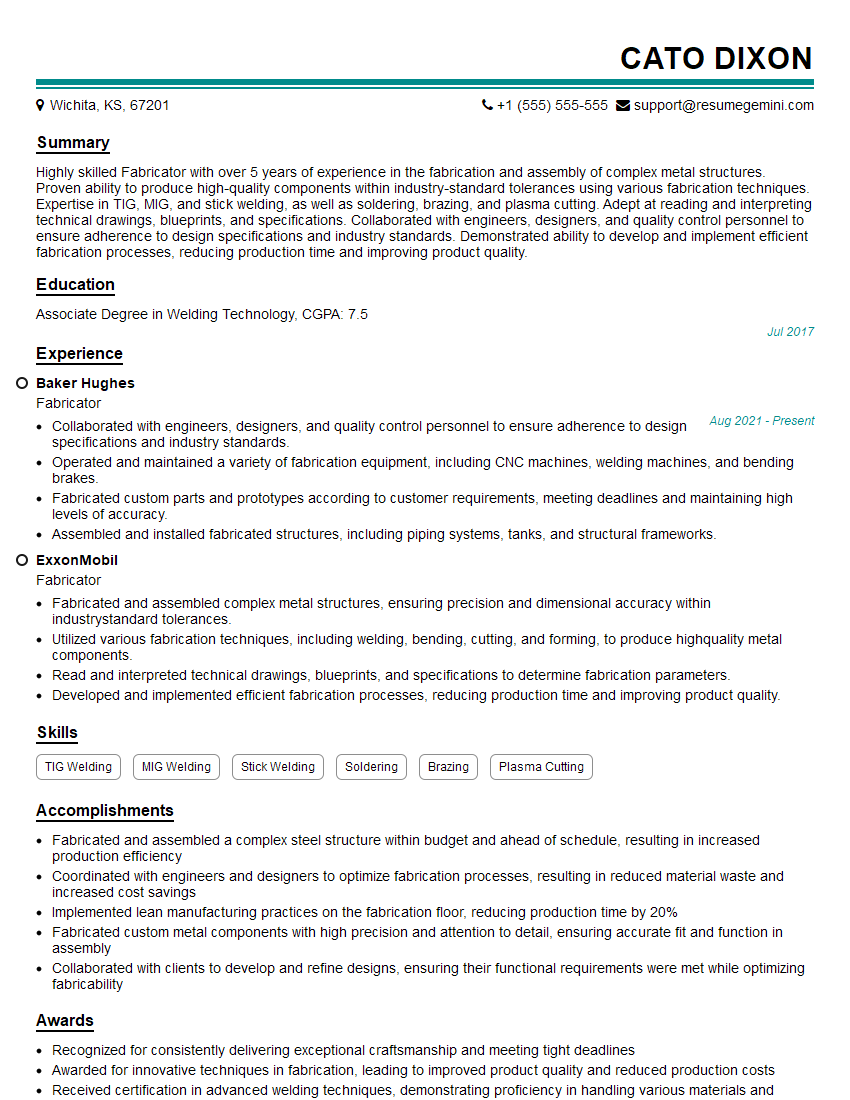Unlock your full potential by mastering the most common Proficient in Use of Hand and Power Tools interview questions. This blog offers a deep dive into the critical topics, ensuring you’re not only prepared to answer but to excel. With these insights, you’ll approach your interview with clarity and confidence.
Questions Asked in Proficient in Use of Hand and Power Tools Interview
Q 1. Describe your experience with different types of hand saws.
My experience with hand saws spans a wide range of types, each suited for different applications. Think of it like choosing the right tool for the right job – you wouldn’t use a scalpel to chop wood!
- Hand Saws: These are versatile for intricate cuts. I’m proficient with coping saws (for curves), tenon saws (precise cuts), and backsaws (for fine woodworking).
- Rip Saws: Designed for cutting *with* the grain of the wood, these saws have large, widely spaced teeth. I’ve used these extensively for rough cuts and dimensional lumber.
- Crosscut Saws: These saws cut *across* the wood grain, featuring smaller, more closely spaced teeth for smoother, cleaner cuts. I often use these for more refined work, like miter cuts.
- Dovetail Saws: These are specialized saws with very fine teeth, perfect for creating the intricate joints of dovetail joinery. They require a delicate touch and precise technique.
For example, when building a birdhouse, I’d use a coping saw for the curved roof and a crosscut saw for the square pieces. The choice depends entirely on the material, the desired cut, and the level of precision needed.
Q 2. Explain the proper safety procedures for using a circular saw.
Safety is paramount when using a circular saw. It’s a powerful tool that can inflict serious injury if not handled correctly. My safety procedures always start before I even turn the saw on.
- Pre-Cut Preparation: I always double-check my measurements and marking before cutting. A precise cut minimizes the risk of kickback.
- Proper Blade Selection: Choosing the correct blade for the material is crucial. Using the wrong blade can lead to damage to the saw or the material, and potentially cause injury.
- Secure Workpiece: The material must be firmly clamped or secured to prevent movement during the cut. This prevents kickback and ensures a straight cut.
- Body Position: I maintain a firm grip on the saw, keeping my body away from the blade’s path. I avoid reaching over the saw, and always use a push stick for narrow cuts.
- Eye and Hearing Protection: Safety glasses and hearing protection are essential. The noise and flying debris can cause serious harm.
- Clear Work Area: Ensuring a clear work area minimizes tripping hazards and provides ample space for safe operation.
Ignoring any of these steps can result in accidents. I always prioritize safety – it’s non-negotiable.
Q 3. How do you choose the right drill bit for a specific material?
Selecting the right drill bit depends entirely on the material you’re drilling. It’s not a one-size-fits-all situation. Think of it like using the right key for the right lock – you wouldn’t use a flathead screwdriver on a Phillips screw.
- Wood: For wood, I typically use twist drill bits. The type of wood may influence the bit size and point angle.
- Metal: For metal, I opt for high-speed steel (HSS) bits, often with a split point for better starting and reduced slippage.
- Masonry: Masonry materials require carbide-tipped masonry bits; these are designed to withstand the abrasive nature of brick, concrete, or tile.
- Plastics: For plastics, I’ll choose a bit that is specifically designed for plastic to avoid melting or chipping.
For example, drilling a hole for a screw in hardwood requires a different bit than drilling through a metal plate. The wrong bit can result in a stripped hole, broken bit, or even injury.
Q 4. What are the different types of screwdrivers and when would you use each?
Screwdrivers come in various types, each designed for specific screw heads. The wrong screwdriver can damage the screw head or the tool.
- Phillips Head: The most common type, with a cross-shaped tip. Perfect for general applications.
- Slotted Head: A simple flat-bladed tip. I use these when I need a simpler, more basic tool.
- Torx: A six-point star-shaped tip, often used in automotive applications and electronics; I find they offer excellent torque and minimize cam-out.
- Hex Head: A hexagonal tip, often used with bolts and machine screws. These are used to fasten larger, sturdier items.
- Square Drive: Offers a good balance between strength and ease of use.
I always select the correct screwdriver to avoid damaging the screw head or stripping it – a frustrating problem to fix. Using the right tool ensures efficiency and prevents mistakes.
Q 5. Describe your experience with various types of hammers and their applications.
Hammers are another area where the right tool for the job is crucial. Different hammers are designed for different tasks.
- Claw Hammer: The most common type, perfect for general carpentry tasks like driving nails and removing them. I use this almost daily.
- Ball-Peen Hammer: Features a rounded, ball-shaped end, commonly used for shaping metal.
- Sledgehammer: A heavy-duty hammer for demolition or driving large stakes; this needs to be approached with caution.
- Rubber Mallet: Used for tasks where impact is needed, but not forceful enough to damage surfaces. I often use this when assembling delicate items to avoid damaging the workpiece.
For example, I’d use a claw hammer to build a deck, a ball-peen hammer for shaping a metal piece, and a rubber mallet to avoid scratching a newly finished surface.
Q 6. Explain the safety precautions for operating a reciprocating saw.
Reciprocating saws, or saws-all, are powerful tools that need to be treated with respect. My safety precautions are stringent.
- Secure Workpiece: The material being cut should always be securely clamped. Movement during the cut can lead to accidents.
- Proper Blade Selection: The blade must match the material. Using the wrong blade can result in a broken blade or an unsafe cut.
- Body Position: I maintain a firm grip and keep my body clear of the blade’s path. I avoid reaching over the saw.
- Eye Protection: Safety glasses are essential to protect against flying debris.
- Proper Ventilation: Reciprocating saws generate dust, so proper ventilation is crucial for health.
- Avoid Overextension: Don’t push the saw too hard, this can cause kickback and injury.
Safety with a reciprocating saw is not just about following guidelines, it’s about developing a respect for its power and potential dangers.
Q 7. How do you maintain and care for your hand tools?
Maintaining my hand tools is crucial for their longevity and my safety. A well-maintained tool is a safe tool.
- Cleaning: After each use, I clean my tools to remove debris, dust, and dirt. This prevents rust and ensures smooth operation.
- Sharpening: Sharp tools are safer and more efficient. I regularly sharpen blades using appropriate sharpening stones or techniques.
- Lubrication: Moving parts, like hinges or jaws, benefit from periodic lubrication with appropriate lubricants. This prevents binding and extends the lifespan.
- Storage: I store my tools in a dry, organized manner. This prevents rust, damage, and simplifies finding the tools I need.
- Inspection: I regularly inspect my tools for any damage or wear. Damaged tools should be repaired or replaced to prevent accidents.
Taking care of my tools is an investment in my work and my safety. It’s a simple yet critical aspect of my craft.
Q 8. How do you troubleshoot a malfunctioning power tool?
Troubleshooting a malfunctioning power tool involves a systematic approach. First, always disconnect the power source – this is paramount for safety. Then, I visually inspect the tool for any obvious problems like damaged cords, loose connections, or broken parts. For example, a circular saw might not start because of a tripped breaker, a faulty cord, or a jammed blade. If the problem isn’t immediately apparent, I’ll consult the tool’s manual for troubleshooting guidance specific to that model. Sometimes, a simple issue like clogged vents or a dull blade can be easily resolved. If the problem persists after checking the obvious and consulting the manual, I might check for internal issues (if I’m comfortable and have the knowledge to do so safely), but often a professional repair is necessary.
I always prioritize safety. If unsure, I always err on the side of caution and consult a professional.
Q 9. What are the common safety hazards associated with power tool use?
Safety hazards associated with power tools are numerous and serious. The most common include:
- Kickback: This occurs when a rotating blade or bit grabs the workpiece and violently throws it back toward the operator. Proper technique and using the right tool for the job minimizes this risk.
- Electrical shock: Working with power tools near water or with damaged cords significantly increases the risk of electric shock. Regular cord inspections and using GFCI (Ground Fault Circuit Interrupter) outlets are essential.
- Blade/bit injuries: Improper handling or accidental contact with moving blades or bits can cause severe cuts or lacerations. Always wear appropriate PPE.
- Repetitive strain injuries (RSI): Prolonged use of power tools can lead to carpal tunnel syndrome or other repetitive strain injuries. Taking regular breaks and using ergonomic techniques are vital.
- Dust inhalation: Many power tools generate significant amounts of dust, some of which can be toxic. Using a dust collection system and wearing a respirator is crucial.
By following safety protocols and using the right PPE, the majority of these hazards can be significantly reduced.
Q 10. Describe your experience using measuring tools like tape measures and levels.
I have extensive experience using measuring tools, which is fundamental to accurate and precise work. Tape measures are used constantly for determining lengths, widths, and overall dimensions of projects. I’m proficient in reading measurements accurately, considering factors like material shrinkage. Levels are crucial for ensuring surfaces are perfectly horizontal or vertical, ensuring structural integrity and aesthetic appeal. For instance, installing shelving requires accurate measurements with a tape measure and ensuring perfectly level shelves using a level – a slight discrepancy can make a significant difference in the overall look and functionality.
Beyond tape measures and levels, I am also proficient in using digital measuring tools, such as laser measures for longer distances and digital angle finders for precise angle measurements.
Q 11. How do you ensure accuracy when using power tools for precise cuts?
Achieving precise cuts with power tools necessitates a multi-pronged approach. First, I always measure twice and cut once. Accurate measurement using a tape measure is critical. Then, I use appropriate jigs, clamps, and guides to ensure the workpiece remains secure and consistent during the cutting process. For instance, a miter saw’s fence and adjustable stops are vital for precise angle cuts. A router table with jigs can help with consistent routing operations. Sharpening blades or bits frequently is also essential. A dull blade will lead to inconsistent cuts and can cause the tool to bind, leading to kickback. Finally, a slow and steady pace ensures control and accuracy.
Q 12. Explain the importance of using the correct personal protective equipment (PPE).
Using the correct personal protective equipment (PPE) is not optional; it’s a non-negotiable aspect of safe power tool operation. The specific PPE depends on the task and the tools used, but generally includes:
- Safety glasses or goggles: Protect eyes from flying debris.
- Hearing protection: Many power tools generate significant noise that can cause hearing damage over time.
- Dust mask or respirator: To prevent inhalation of harmful dust particles.
- Gloves: Protect hands from cuts, splinters, and abrasions.
- Work boots: Provide protection from falling objects and heavy materials.
- Appropriate clothing: Clothing should be close-fitting, free of loose sleeves or dangling items that could get caught in machinery.
Ignoring PPE significantly increases the risk of serious injury. It’s an investment in personal safety and wellbeing.
Q 13. Describe your experience with various types of woodworking tools.
My woodworking tool experience is extensive and encompasses various types. I’m proficient with hand tools like chisels, planes, saws (hand saws, coping saws, tenon saws), and mallets for detailed work and shaping. For power tools, I’m experienced with various types of saws (circular saws, miter saws, table saws, jigsaws), routers, planers, sanders (belt sanders, orbital sanders), and drills. I’m also comfortable using specialized tools like jointers and shapers when appropriate for the project. I am comfortable using both stationary and portable power tools.
Q 14. How do you handle different types of wood with appropriate tools?
Handling different types of wood requires adapting tools and techniques. Hardwoods like oak and maple require sharper blades and potentially slower feed rates to avoid tearing. Softer woods like pine and fir are easier to work with but can be more prone to chipping if not handled correctly. The choice of blade or bit is also crucial. For example, a fine-toothed blade is preferable for hardwoods to achieve a cleaner cut, while a coarser blade might be suitable for softer woods. Additionally, the moisture content of the wood impacts its workability. Dry wood is generally easier to work with, whereas green or damp wood is more prone to chipping and tearing.
I always select tools and techniques appropriate for the specific wood type and its condition. For instance, a sharp chisel works well with hardwoods for detailed carving, while a router with a specific bit would be better for shaping larger pieces.
Q 15. How do you diagnose and fix common problems with woodworking equipment?
Diagnosing and fixing problems with woodworking equipment involves a systematic approach. First, I identify the issue: Is the machine not powering on? Is it making unusual noises? Is it producing inaccurate cuts? Then, I proceed with troubleshooting. For example, if a table saw is not powering on, I’d first check the power cord, outlet, and circuit breaker. If the problem persists, I might inspect the motor’s wiring and components, potentially needing to replace a faulty capacitor or motor brushes. Unusual noises often indicate loose parts, worn bearings, or blade issues. Inaccurate cuts usually point to blade alignment problems, damaged fence, or improper blade selection. I approach each problem methodically, starting with the simplest solutions and progressing to more complex repairs only when necessary. I always prioritize safety, ensuring the machine is unplugged before any internal inspection or repair.
For instance, I once had a router malfunction mid-project. It started making a grinding noise. After safely disconnecting the power, I opened it up and discovered a small piece of wood had jammed the mechanism. Removing the obstruction solved the problem immediately. In another instance, a planer wasn’t producing a smooth finish. After checking the blade sharpness and alignment, I found that the feed rollers were worn and needed replacement, restoring the machine to its proper function.
Career Expert Tips:
- Ace those interviews! Prepare effectively by reviewing the Top 50 Most Common Interview Questions on ResumeGemini.
- Navigate your job search with confidence! Explore a wide range of Career Tips on ResumeGemini. Learn about common challenges and recommendations to overcome them.
- Craft the perfect resume! Master the Art of Resume Writing with ResumeGemini’s guide. Showcase your unique qualifications and achievements effectively.
- Don’t miss out on holiday savings! Build your dream resume with ResumeGemini’s ATS optimized templates.
Q 16. Explain your experience with metalworking tools and techniques.
My experience with metalworking tools extends to various operations, including cutting, shaping, and finishing. I’m proficient in using a variety of hand tools such as files, hacksaws, and chisels, as well as power tools like angle grinders, bench grinders, and drill presses. I’m comfortable working with different metals, including steel, aluminum, and brass. I understand the importance of selecting the right tool for the job and using appropriate safety measures. For example, I know that using the wrong cutting speed or pressure can lead to broken tools or injuries. I also understand the need to properly lubricate tools to extend their lifespan and ensure efficient operation.
A recent project involved fabricating a custom metal bracket. I used a bandsaw to cut the metal to shape, a milling machine to create precise holes, and a file to smooth the edges and remove burrs. I finished the bracket with a durable coating to protect against corrosion. Understanding metal properties and tool capabilities is vital to achieving a successful outcome. For instance, I had to use a different cutting technique and a lower cutting speed on stainless steel to prevent tool damage and workpiece overheating compared to the technique used for mild steel.
Q 17. Describe your experience using welding equipment and safety procedures.
My experience with welding equipment includes MIG, TIG, and stick welding. I am familiar with various welding processes and their applications. I also have a strong understanding of safety procedures which are paramount in welding. This includes wearing appropriate Personal Protective Equipment (PPE) such as welding helmets with appropriate shade lenses, welding gloves, long-sleeved shirts, and fire-resistant clothing. I’m well-versed in ventilation requirements to remove harmful fumes, and I understand the importance of fire safety, including having a fire extinguisher readily available. Before starting any welding project, I always inspect the equipment to ensure it is in good working order and correctly set up for the intended welding process. I am also careful to assess the surrounding environment to ensure there is no flammable material nearby.
During a recent project involving the repair of a steel frame, I used MIG welding due to its speed and ease of use for joining thicker pieces of metal. However, for welding thin sheet metal, I opted for TIG welding to achieve precise control and prevent burn-through. I always double-check my work and ensure the weld meets the required strength and quality standards. This involves cleaning the weld area after welding to remove any slag and ensuring proper penetration and fusion.
Q 18. How do you select the appropriate welding technique for a given job?
Selecting the appropriate welding technique depends on several factors: the type of metal being welded, the thickness of the metal, the desired weld quality, and the accessibility of the joint. For instance, MIG welding (Gas Metal Arc Welding) is ideal for faster, higher-volume work on thicker materials like steel. TIG welding (Gas Tungsten Arc Welding), is best for precision work requiring high-quality welds on thinner materials and those that require a cleaner finish, and it’s versatile across various metals. Stick welding (Shielded Metal Arc Welding) is a robust technique for outdoor projects or situations where access is limited, and it’s generally less sensitive to environmental factors. Each technique requires different skills and safety protocols. My experience allows me to make informed decisions based on the job specifications to ensure the most efficient and effective weld.
For example, in a project involving welding thin aluminum sheets, TIG welding was the clear choice due to its ability to produce a clean, strong weld with minimal distortion. However, for joining heavy steel beams in a structural framework, MIG welding provided a more efficient solution due to its speed and ease of use.
Q 19. Describe your experience with plumbing tools and techniques.
My experience with plumbing tools and techniques encompasses a wide range of activities, from pipe fitting and soldering to fixture installation and repair. I’m proficient in using various hand tools such as pipe wrenches, basin wrenches, and pliers, as well as power tools such as pipe cutters and drain augers. I understand different pipe materials, their properties, and appropriate joining techniques. I’m familiar with various plumbing codes and regulations. I also understand the importance of proper water pressure management and leak detection.
I once repaired a leaky faucet by identifying the faulty O-ring and replacing it, a simple yet effective solution. In another case, I troubleshooted a clogged drain using a drain snake and successfully removed the obstruction, restoring proper drainage. Understanding the underlying principles of water flow and pressure is crucial for efficient and effective plumbing solutions.
Q 20. How do you troubleshoot common plumbing issues?
Troubleshooting plumbing issues involves a systematic approach. I start by identifying the problem: Is it a slow drain, a leaky faucet, low water pressure, or no water at all? Then, I use various techniques to pinpoint the cause. For slow drains, I might use a plunger or a drain snake to clear clogs. For leaky faucets, I inspect the cartridges, seals, and O-rings, replacing any damaged components. Low water pressure might indicate a problem with the main water line or a clogged aerator. No water at all suggests a problem with the main shut-off valve or a leak in the water line. I always turn off the water supply before making repairs and use the appropriate tools for the job.
For example, I once resolved a low water pressure issue in a house by identifying and clearing a sediment buildup in the water pressure regulator. Another time, I fixed a running toilet by adjusting the fill valve and flapper, preventing needless water waste.
Q 21. What are the safety precautions for working with electrical tools?
Safety precautions when using electrical tools are paramount. This begins with wearing appropriate personal protective equipment (PPE), including safety glasses or a face shield to protect against flying debris, hearing protection to reduce noise-induced hearing loss, and work gloves to enhance grip and protect hands. Before using any power tool, I carefully inspect it to ensure it’s in good working order, checking for any frayed cords, damaged insulation, or loose parts. I always ensure the work area is well-lit and free of clutter, to prevent accidents. I disconnect the tool from the power source when changing blades or bits or if leaving the tool unattended. I never work with electrical tools in damp or wet conditions. I always use the correct extension cords, avoiding overloaded circuits. And, most importantly, I always maintain awareness of my surroundings to minimize risks.
For example, I always double-check the cord insulation of my circular saw before each use and never operate it without safety glasses. This preventative approach helps ensure a safe and productive working environment.
Q 22. Explain your experience with electrical wiring and installation.
My experience with electrical wiring and installation spans over ten years, encompassing residential, commercial, and industrial settings. I’m proficient in various wiring methods, including Romex, conduit, and BX cable, and I’m familiar with all relevant electrical codes and safety regulations (NEC). I’ve worked on projects ranging from simple outlet replacements to complex three-phase installations. For instance, on a recent commercial project, I was responsible for running conduit and wiring for a new HVAC system, ensuring proper grounding and adhering to all safety protocols. This involved careful planning of the wiring routes, selecting appropriate conduit sizes, and using the correct amperage breakers. I’m comfortable with troubleshooting electrical issues, identifying short circuits, and performing necessary repairs.
I understand the critical importance of accurate measurements and adherence to color-coding standards to prevent accidents and ensure the longevity and safety of the electrical system. I’ve always prioritized safety during the entire process, from initial planning to final inspection.
Q 23. How do you ensure the safe use and storage of power tools?
Safe use and storage of power tools are paramount. My approach is built around three key principles: proper maintenance, secure storage, and safe operating practices. Before using any power tool, I always inspect it for damage, ensuring all guards are in place and functioning correctly. I also check the power cord for any fraying or damage. After use, I clean the tools thoroughly, removing any debris or dust that could affect their performance or cause damage. This includes lubricating moving parts as needed.
For storage, I use a dedicated, well-organized tool cabinet or rack, keeping tools secure to prevent accidental damage or theft. Sharp tools like chisels are stored separately and securely, with their blades protected to avoid injury. I also label tools clearly for easy identification. All power tools are unplugged and stored in a dry, safe location, away from potential hazards like moisture or extreme temperatures. This systematic approach minimizes risks and ensures the tools remain in optimal condition for future use.
Q 24. Describe your experience working with pneumatic tools.
I have extensive experience working with pneumatic tools, primarily in demolition and construction projects. My expertise includes using air compressors, nail guns, impact wrenches, and sanders. I understand the importance of proper air pressure regulation for each tool, as incorrect pressure can lead to damage, inefficiency, or safety hazards. I am familiar with the maintenance requirements of pneumatic tools, including regular lubrication and filter changes. For instance, I recently utilized an air-powered demolition hammer to efficiently remove a section of concrete, ensuring the compressor was adequately sized for the job and regularly monitoring the air pressure to prevent overheating and malfunctions. Proper safety equipment, such as hearing protection and eye protection, was always utilized.
In addition to operational experience, I am knowledgeable about troubleshooting common pneumatic tool issues, such as air leaks or malfunctions of the internal mechanisms. Understanding the principles of pneumatics allows me to quickly diagnose and resolve problems to maintain efficiency and productivity on the job site.
Q 25. How do you identify and address potential hazards when using power tools?
Identifying and addressing potential hazards when using power tools is a critical aspect of my work. My approach is proactive, starting with a thorough risk assessment before commencing any task. This includes identifying potential hazards like loose clothing, nearby obstructions, and the presence of flammable materials. I then implement appropriate control measures, such as wearing safety glasses, hearing protection, and work gloves. Additionally, I ensure the work area is well-lit and free of clutter.
During operation, I maintain a firm grip on the tool and use the correct technique to minimize the risk of kickback or other accidents. For example, when using a circular saw, I always ensure the blade guard is in place and I use a push stick to avoid my hand getting too close to the blade. I also regularly check the tool for any signs of damage or malfunction and cease operation immediately if any issues arise. My commitment to safety is unwavering, and I prioritize preventative measures to avoid accidents.
Q 26. How do you maintain and clean power tools after use?
Maintaining and cleaning power tools after use is crucial for their longevity and safe operation. My process always begins with unplugging the tool from the power source. Next, I remove any debris or dust from the tool’s body, using compressed air or a brush, taking care to avoid damaging any delicate components. I then lubricate moving parts, as specified by the manufacturer’s instructions. This might involve applying a specific lubricant to bearings or other moving parts to ensure smooth and efficient operation. For tools with changeable blades or bits, I clean and sharpen these separately, storing them safely until their next use. Finally, I inspect the power cord for damage and store the tool in its designated location, ensuring it’s secure and protected from damage.
This regular maintenance ensures the tool performs at its peak and extends its lifespan significantly, preventing expensive replacements and downtime. A well-maintained tool is also a safer tool, reducing the risk of accidents or malfunctions.
Q 27. Describe a time you had to troubleshoot a problem using hand tools.
During a recent renovation project, I encountered a problem with a stubborn stripped screw in a very tight space. A power screwdriver wouldn’t fit, and simply trying to remove it with pliers risked further damage. Instead, I utilized a set of hand tools: a small, high-quality screwdriver with a precision tip, a hammer, and a punch. First, I carefully applied penetrating oil to the screw to loosen it. Then, using the punch to apply controlled force directly to the screw head, I managed to turn it out slowly, minimizing further damage to the surrounding wood. Finally, I carefully cleaned the hole to prepare for a replacement screw of the correct size. This situation showcased the importance of adapting your approach based on the specific constraints of the task and the availability of hand tools to complete the job successfully and without damaging the material.
Q 28. Describe a time you had to repair a damaged tool.
On one occasion, the chuck of my cordless drill became damaged, making it impossible to securely clamp drill bits. After careful inspection, I determined that the internal mechanism that controls the chuck’s grip was malfunctioning. Instead of immediately replacing the drill, I decided to attempt a repair. I consulted the manufacturer’s service manual and, using a small precision screwdriver set, carefully disassembled the chuck. I cleaned it thoroughly and identified a small broken spring that was the root cause of the problem. Fortunately, I was able to source a replacement spring online and, following the service manual’s instructions, carefully reassembled the chuck. After reassembly and testing, the drill was fully functional once more. This repair saved time and money compared to buying a new tool, and it demonstrated my resourcefulness and ability to troubleshoot and resolve mechanical issues.
Key Topics to Learn for Proficient in Use of Hand and Power Tools Interview
- Safety Procedures and Regulations: Understanding and applying relevant safety protocols for hand and power tools, including PPE usage and emergency procedures. This includes knowing the specific hazards associated with different tools.
- Hand Tool Proficiency: Demonstrating practical knowledge and skill in using various hand tools such as hammers, screwdrivers, wrenches, saws, levels, and measuring tapes. Be prepared to discuss different types and their applications.
- Power Tool Operation and Maintenance: Understanding the operation, maintenance, and safety precautions for common power tools like drills, saws (circular, reciprocating, miter), routers, sanders, and impact wrenches. Knowing how to troubleshoot minor issues is crucial.
- Material Selection and Application: Demonstrating knowledge of different materials (wood, metal, plastic) and selecting the appropriate tools and techniques for working with them. This includes understanding material properties and their impact on tool selection.
- Measurement and Precision: Highlighting your ability to accurately measure, cut, and shape materials using various tools and techniques. This includes understanding tolerances and achieving desired results.
- Project Planning and Execution: Demonstrating your ability to plan and execute projects efficiently and effectively, considering factors like time management, resource allocation, and problem-solving. Be prepared to discuss your approach to tackling complex tasks.
- Troubleshooting and Repair: Explaining your problem-solving skills when encountering issues during projects. This involves identifying the root cause of problems and finding effective solutions using available tools and resources.
Next Steps
Mastering the proficient use of hand and power tools is essential for career advancement in many skilled trades and technical fields. A strong understanding of these skills demonstrates competency, reliability, and attention to detail – highly valued attributes in any workplace. To maximize your job prospects, creating an ATS-friendly resume is critical. ResumeGemini is a trusted resource that can help you build a professional and impactful resume, showcasing your skills effectively. Examples of resumes tailored to “Proficient in Use of Hand and Power Tools” are available to help guide your resume creation process. Invest time in crafting a strong resume – it’s your first impression on a potential employer.
Explore more articles
Users Rating of Our Blogs
Share Your Experience
We value your feedback! Please rate our content and share your thoughts (optional).
What Readers Say About Our Blog
Hello,
We found issues with your domain’s email setup that may be sending your messages to spam or blocking them completely. InboxShield Mini shows you how to fix it in minutes — no tech skills required.
Scan your domain now for details: https://inboxshield-mini.com/
— Adam @ InboxShield Mini
Reply STOP to unsubscribe
Hi, are you owner of interviewgemini.com? What if I told you I could help you find extra time in your schedule, reconnect with leads you didn’t even realize you missed, and bring in more “I want to work with you” conversations, without increasing your ad spend or hiring a full-time employee?
All with a flexible, budget-friendly service that could easily pay for itself. Sounds good?
Would it be nice to jump on a quick 10-minute call so I can show you exactly how we make this work?
Best,
Hapei
Marketing Director
Hey, I know you’re the owner of interviewgemini.com. I’ll be quick.
Fundraising for your business is tough and time-consuming. We make it easier by guaranteeing two private investor meetings each month, for six months. No demos, no pitch events – just direct introductions to active investors matched to your startup.
If youR17;re raising, this could help you build real momentum. Want me to send more info?
Hi, I represent an SEO company that specialises in getting you AI citations and higher rankings on Google. I’d like to offer you a 100% free SEO audit for your website. Would you be interested?
Hi, I represent an SEO company that specialises in getting you AI citations and higher rankings on Google. I’d like to offer you a 100% free SEO audit for your website. Would you be interested?
good


